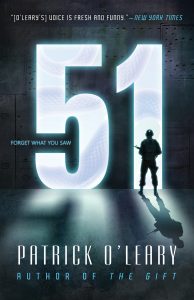Gary K. Wolfe Reviews 51 by Patrick O’Leary
 51, Patrick O’Leary (Tachyon 978-1-61696-348-4, $16.95, 304pp, tp) February 2022.
51, Patrick O’Leary (Tachyon 978-1-61696-348-4, $16.95, 304pp, tp) February 2022.
Patrick O’Leary hasn’t been the most prolific of writers (it’s been almost 20 years since his last novel, The Impossible Bird, and that was only his third), but he’s certainly among the most unexpected. He characteristically begins with familiar SF/F devices (time travel in Door Number Three, alien invasions and immortality in The Impossible Bird), and then veers off into subtly complex explorations of character, family ties, and the nature of storytelling itself (which was the central theme in 1998’s The Gift). So a reader who picks up his new novel 51 based on nothing more than its title and an ominous-looking armed soldier on the cover might be forgiven for expecting yet another X-Files-flavored paranoid fantasy about government cover-ups and aliens-in-the-cupboard, but they’d be in for a few surprises. For one thing, it’s way more paranoid than that. What if the whole crashed-spaceship-and-hidden-aliens scenario was itself a cover story to divert attention from a far more disturbing and inexplicable discovery, which has unfolded over decades? (This is hardly a spoiler, since we learn it only a few chapters in.)
Adam Pagnucco, or Nuke, a 73-year-old photographer, is driving home from an AA meeting during a brutal Detroit winter when he rescues an apparently homeless guy who turns out to be his old friend Winston Koop, whom he hasn’t seen in decades. Koop begins unfolding a bizarre tale beginning in 1972, when he met his future wife at a secretive military installation, where she told him of a portal called the door to Anywhere, discovered at the site of the Trinity A-bomb sometime before the end of WWII. The creatures who come out of the portal are called Imaginary Friends or Ifs, since they are invisible to most people and may appear in different forms to each of those who can see them – an undulating shadow, a small child, an enormous white snake, even a marshmallow – though we eventually learn their characteristic form looks something like a plant with a concave opening at the top. As Koop’s tale skips wildly back and forth through decades from the 1940s to the present and through locations ranging from the La Brea tar pits to DC, it’s easy to identify with Nuke’s comment, ‘‘Now I’m really confused’’ – though we’re hardly surprised when Koop responds, ‘‘I’m just getting started,’’ which might be the whole novel’s mantra.
Koop’s main task, it seems, has been to selectively erase the memories from scores of people who have encountered the IFs – with something like Men in Black’s neuralyzers, I guess – though he himself develops lasting friendships with a couple of them. Every American president is secretly told about the portal, of course, which gives O’Leary some choice opportunities for understated political satire, but what gradually emerges from this scattered narrative, as with earlier O’Leary novels, is a deeply felt exploration of friendship, loyalty, memory, and growing old. Of course, we’re never quite sure how much of Koop’s story should be taken at face value, but his rekindled friendship with Nuke develops a rich texture, as does his devotion to the IFs, as enigmatic as they are. While some of O’Leary’s short chapters are filled with such snappy banter that they seem ready for the screen, there are also passages of truly lovely prose to remind us that this is much more than a conspiracy thriller. Koop’s enduring message to his IF friends, toward the end, is simply ‘‘You were loved.’’ It’s a message of self-discovery familiar from O’Leary’s other novels, but, as always, it’s a bit surprising to realize how skillfully and shrewdly he’s prepared us to believe it.
Gary K. Wolfe is Emeritus Professor of Humanities at Roosevelt University and a reviewer for Locus magazine since 1991. His reviews have been collected in Soundings (BSFA Award 2006; Hugo nominee), Bearings (Hugo nominee 2011), and Sightings (2011), and his Evaporating Genres: Essays on Fantastic Literature (Wesleyan) received the Locus Award in 2012. Earlier books include The Known and the Unknown: The Iconography of Science Fiction (Eaton Award, 1981), Harlan Ellison: The Edge of Forever (with Ellen Weil, 2002), and David Lindsay (1982). For the Library of America, he edited American Science Fiction: Nine Classic Novels of the 1950s in 2012, with a similar set for the 1960s forthcoming. He has received the Pilgrim Award from the Science Fiction Research Association, the Distinguished Scholarship Award from the International Association for the Fantastic in the Arts, and a Special World Fantasy Award for criticism. His 24-lecture series How Great Science Fiction Works appeared from The Great Courses in 2016. He has received six Hugo nominations, two for his reviews collections and four for The Coode Street Podcast, which he has co-hosted with Jonathan Strahan for more than 300 episodes. He lives in Chicago.
This review and more like it in the January 2022 issue of Locus.
 While you are here, please take a moment to support Locus with a one-time or recurring donation. We rely on reader donations to keep the magazine and site going, and would like to keep the site paywall free, but WE NEED YOUR FINANCIAL SUPPORT to continue quality coverage of the science fiction and fantasy field.
While you are here, please take a moment to support Locus with a one-time or recurring donation. We rely on reader donations to keep the magazine and site going, and would like to keep the site paywall free, but WE NEED YOUR FINANCIAL SUPPORT to continue quality coverage of the science fiction and fantasy field.
©Locus Magazine. Copyrighted material may not be republished without permission of LSFF.






